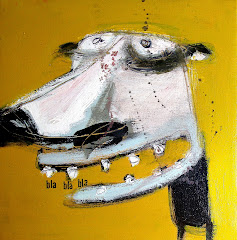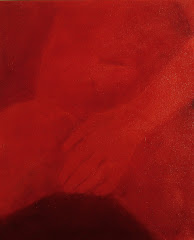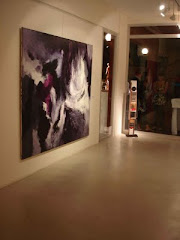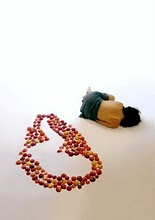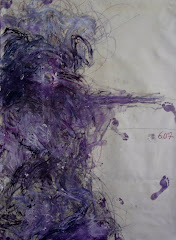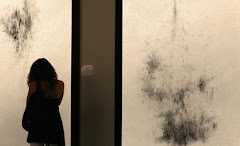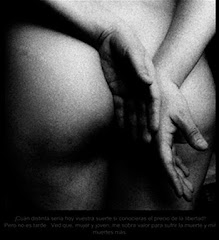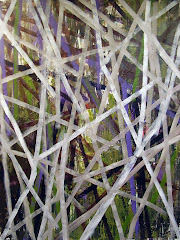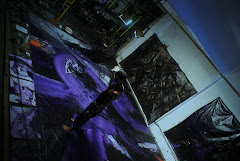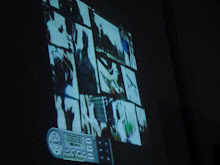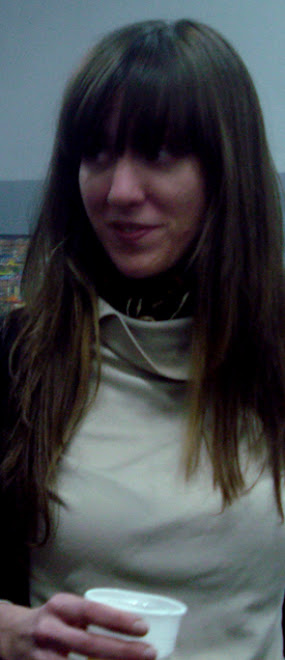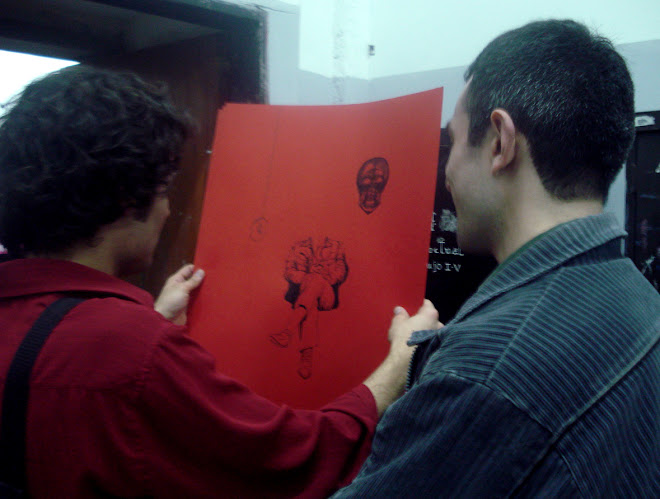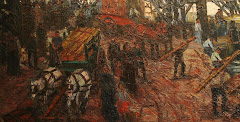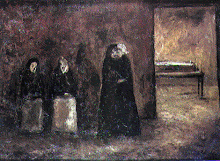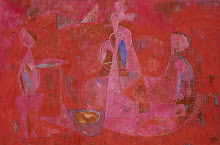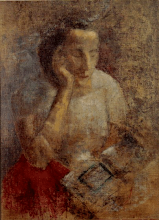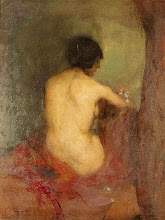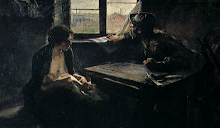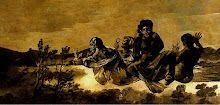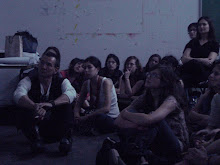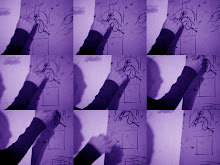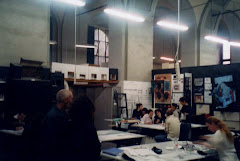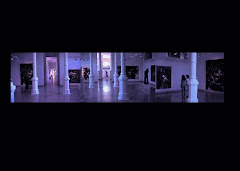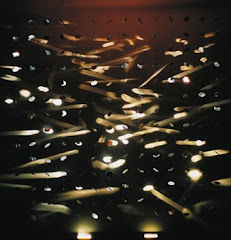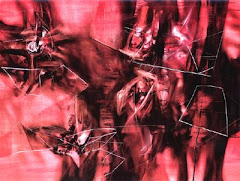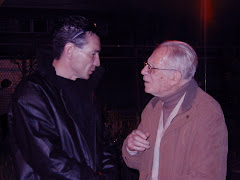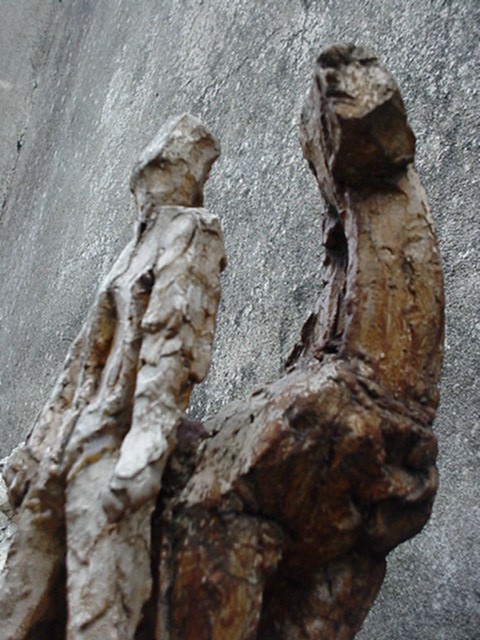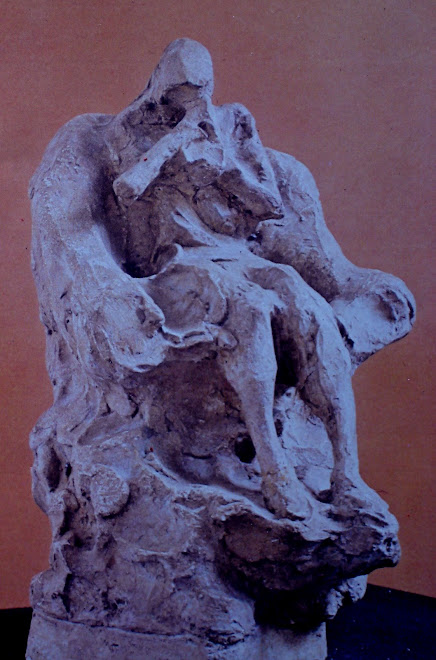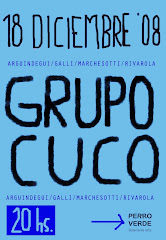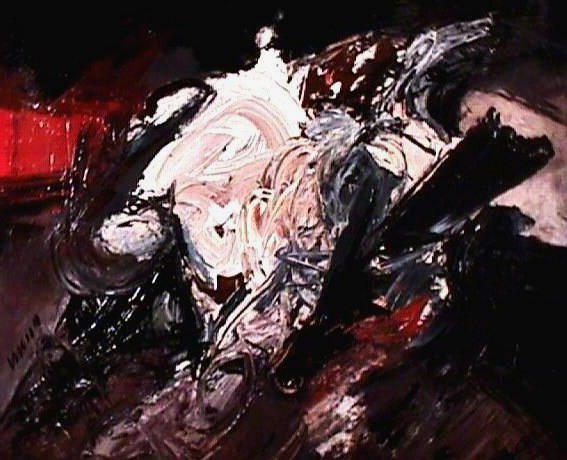.
.
.
Catalina Chervin and the writing of the Figural
By Guillermo Cuello. Visual Artist. Painter
>> L´ art à son époque de dissolution, en tant que mouvement négatif qui poursuit le dépassement de l ´art
dans une société historique où l ´histoire n ´est pas encore vécue, est à la fois un art du changement et
l ´expression pure du changement impossible. Plus son exigence est grandiose, plus sa véritable réalisation
est au delà de lui. Cet art est forcément d ´avant garde, et il n´est pas . Son avant-garde est sa disparition << .
Guy Debord. T. 190 . La Sociedad del Espectáculo. Pág. 185. Ed. Folio. Gallimard 1996, ( 2006 para la impresión de Barcelona ) .
Edición original: La Societé du Spectacle / 1967 , Ed. Buchet-Chastel, París.
It is always rather difficult for the spectator to understand certain aspects of the outcome of an artist's work, as well as specific processes associated to it. In particular with regards to what concerns the break up of what we can call “the cliché” (1).
It is often interesting to observe the ways in which many creators, as well as contemporary “domesticated” curators can make of the cliché – with its uniformity and mediatic acceptance – works of art of certain relevance. Those art works would ultimately find their way not only to compulsive sales, but to rapid and massive consumption, and to what, for lack of a better term, is know in Guy Debord’s “Society of the Spectacle,” as “The Fair”.
Nevertheless, I recognise a different set of values, for those who research the deliberate visual exploitation of stereotypes –either in ‘cachet, ‘griffe’ or ‘stamp’– to which we add the vast spectrum of other productions by contemporary artists who take up the strictly linguistic connotations of the ‘visual language’ and the production of ‘new signs’, where the latter are manipulated and transformed into simple excuses, reducing them to the role of illustrating theories.
These aspects of the art world– fortunately – are not the ones we should consider in case of the case of Catalina Chervin’s work, if we consider it as a whole that has been growing to the rhythm of a persevering pulsation, to a vibration and a beat that do not end in the present. Rather those engines witness the perseverance of a tenacity very seldom seen, recognized or even admired in our latitudes.
I believe that the concepts involved within the sensitive development of her work deserve to be analysed more deeply, in order to try to examine this complex universe from a different and more precise viewpoint, from a perspective that is both autonomous and different, and which, obviously, even using the most sophisticated instruments (those of decoding a ‘visual text’ within our reach) will never be able to ‘explain’ this work.
Arthur Danto could find here a complete justification for his idea about art as ‘incarnate meaning’ and he would be completely right in this case. Modestly I dare to complete this vision, referring to ‘incarnate meanings and concepts’ (the mind is also body) such as – expanded field-, that maybe helps to a better approach of what’s becoming in the centre of a disegno in its widest sense.
When we stand in front of a piece of work of Catalina, after exploring the different densities of the atmosphere, the transparent, clear and open production through her drawing, we find the prints of entwined bodies, gathered together around under a common form.
Chervin breaks the cliché through a sharp development of the formal intelligence, always present in her works, in every different period or series. An example of this are the recent pieces of the “Apocalypses” and “The Poems” exhibited at the Mamam Gallery in Buenos Aires (2)
Without falling in a trap nor in the excess of “hard literal decodification”, obviously her body-signs, sometimes hidden and self- related others explicit, behave as simple traces that suggest, within the diversity of surfaces, rather than making the line become obvious. These are not of course the results of placing her body within the confines of a Naturalistic or Realistic production. It is not that kind of Poetry. Instead we are in front of a domain of assimilation, a power of abstraction an association and inner production that owes more to the subjective, than to the details of the constructive, or the “deconstructive” of the phenomenological information properly abstracted, or to the deliberated searched and founded cultural products.
This materialization of articulated bodies exceeds in their making the mere classification of what “Figurative is”.
In terms of the fracture of the cliché (in terms of the body, the carnality instincts which are inherent to it; in terms of people, subjects and the anatomical shape which the body connotes) she proceeds from a very peculiar series of writings, “a diagram” (according to Francis Bacon) with a rhythm and pulse of her own.
It’s an authentic original and unknown work of art. A work that tends to minimize the data of the figurative, or the anecdotic data towards the domain of The Figural (3) which exacerbates the freedom and autonomy of the figures with regards to what we can identify as “objective world” and its transposition in the bi-dimensional plane.
It is worth to point out that this kind of symbolization is not related, I believe, to the Surrealistic world and even less to one aspect of this great and well known historic isthmus, as Catalina Chervin does not need, nor does she boast, a ‘psychic pure automatism without being controlled by reason,’ not even the unconscious universe or the transpositions of dream worlds
It is indispensable to highlight this idea, as some of her writings could be associated with the excellent and magisterial ‘corporal cartography’ of a Henri Michaux. It is worth mentioning, however, that Chervin’s are not the result of a spectrum of possibilities obtained by having been immersed in the use of hallucinogenic drugs (such as mescaline or peyote )in order to reach – once ‘the supports of reason have been broken down’ – that with which she has a connection that is direct, natural, innocent, but not naive.
Here, the ‘gift of listening to what is being dictated’ in deep and even ‘atavistic’ way, –which emerges out of the depths, from the most obscure and secret meanders of the spirit, or from that which has been genuinely inherited, taking also into account the awareness of this fact, – is what leaves us to enjoy the domain of consciousness, which prevents that the project vanished in opposite directions, as Henri Moore wisely warned us a long time ago.
The end result is having followed a line with majesty, with the necessary subtlety, where finally that which is conscious, the ability in the use of the pencil or brush and essentially elaborated spontaneity, replace direct automatism.
From the perspective of the artist, who values that needed balance between praxis and gnosis, where both categories share action in common, one is sure that Catalina Chervin ‘talks to us’ about a whole that organizes, sustains, articulates and composes a sort of ‘epistemological knot’ for her visual conception.
We are here in the centre of a form, understood almost as a parallel and/or equivalent to a structure and to its possible questioning.
It is a daunting topic for the Critical Theory (as could be done by a specialist and theoretic of the quality of Robert Morgan) (4) to determine if the structure comes before the form, or emphatically point out which one is the source and possibility of the other.
Far from trying to solve the debate, we will take this proposed form, as a formative form, without which, the figures would run the risk of being dissolved in an amorphous magma, which becomes insufficient when a specific definition is needed.
It is this unit, taken from its formative source, that lies below, underneath, in a hidden manner or as proceeding from the depth with metaphysical implications – such as a suggestion of ‘absent structure’ – the one we have to discover, in order that our approach be respectful and precise when facing this production. So the “expanded” contemplation be as pleasant as distressing.
The general articulation, the non deliberate fragmentation of the foundational plastic elements of her drawing, leave us naked in the face of a work of art that situates itself in the field of the meaningful and that completely rejects that which is merely symptomatic.
And now:
-Which are the distinctive signs of this formative form?
-Where does the artist place her own body in relation to it?
I distinguish at least three great sources that, like great conductive roots, tend to feed and make possible the formative development to which we are exposed.
On the one side, the fact of paying a sensitive and sustained attention to those forces that, from the order of the invisible, appear and disappear as an embryonic shape in order to develop into a ‘progression of the cosmic’.
Probably, it will be discovered that that universe ‘with no form’ yet, as territory of what ‘The human is not’ may have some connection within a long cultural tradition, within certain powerful mysticism. It may be that, in a way, the nervous and electrifying scriptures Catalina proposes, are indirectly a tactile, haptic– in a laconic way – aspect, a frequently revisited one– in the manner propose in the tale of the Golem’ (5) Reduction ad absurdum? Perhaps, if we believe ‘The Golem’ to be something which is at the beginning and has The Apocalypse as it’s opposite at the other end. Perhaps, precisely the paradoxical cut or contradiction may be resolved in the drawing.
Let us agree also that Philosophy now-a-days, investigates Art but not so much the other way around. We can continue and suggest that we work from that position by conjuring in a certain way, those forces, to the point of making them our own, to give plastic form to what remains enclosed in the arrogance of its essence.
From another point of view, there is a ’celerity’ in the sketching, in that command of a-significant signs that articulate Chervin’s diagram. A succession of lines, scratches, amendments (as well as deliberate erasing) comparable by their speed, to the work of those ‘old listeners and scribes’. These ones, with great skill and speed, used to fill the damp slates of clay with meaningful signs, from right to left, forced, of course, by the position of the support between the knees, the weight of their backs and the curve on their writing boards, boards which owned transcendent truths, Scribes limited in their craft by the special tools they used that dangled from their left hand, as well as from the certain knock of the right hand over the ‘talking tools’.
A third way to see Chervin’s work would be the one we could take into account from a psychological aspect, where the real, the imaginative and symbolic, do not appear here as ‘stale compartments’ or as suspended and hieratical ‘cells’ or schematic archetypes, without possible modification, but rather interacting dynamically to assist the hand in its subtle chores.
We have then a circular form, or rather a circulating, not static one that tends to embrace in a conscientious fight the different climates, as well as not to abandon even one square centimetre of the surface of what Catalina is carefully going through.
The fact is that the image is also that: each millimetre intensely disputed to what the paper proposes as an exploratory field.
Nothing of all this would be possible, without the professional selection of materials and supports to produce different intensities of black, greys, whites, semitones, main aspects in the materialization of this Poetry, which has as a main character in this metier the force that runs from the elbow to the wrist and from there to the fingertips, like an undeniable single-directed vector, which assumes the main role in her works.
There is no pompous or virtuous gesture from the shoulder to the hand, with its material and sensual extensions. Better still, here we find the strength of the straight angle, the mind associated to the ortogonality that through practice some of us, as artists, know, and which ends in the pencil or in the tip of the brush operating with the precision of a surgeon.
This can be confirmed, from the moment in which we stop to read patiently the delicate modulations of her trace, ‘the adjustments of form’, ‘the changes in the timings of the mark’, the meticulous definition of a limit, an edge, a trace. All this reminds me of the adjustments of what a Filevich in Argentina was capable of doing with his xylography. Traces, signs, in the end, which should be followed until the last breath of her journey.
This, of course, is drawing at the highest level.
Such a dimension would not be apprehensible, even in a fragmentary way, without always considering that every artist, in a greater or lesser degree, commits his or her body in the creation of each work. The expression ‘to put ones body’ says a lot with respect to our colloquial language (portenio)
Without being too strict or literal, we could modulate the creative act, asserting that there is an eventual projection of the body itself during the creation of a work of art based on signs that are not always rhetoric, but intensely visceral.
A painting from Paul Klee comes in my aid to express with certain parameters, where it is that I believe Catalina Chervin, places herself, as she should, from a physical-spiritual point of view. It is an image that could help answering and complete our second question regarding the placement of the artist’s body within the formative form of the work.
In ‘Vorhaben’ (Projet or Proyect) of Klee (an emulsion of pigments with glue on newspaper, of 75 x 112 cm, from 1938, held in the Paul Klee Foundation of Kunst Museum, in Bern, Switzerland) we are subjugated by a protagonist silhouette . It is a figure ‘of half a body, submerged within two different and at the same time asymmetric, fields” in relation to the proportions of the areas presented by the work.
It may be a feminine figure that, taken two thirds of its surface from the right part of the picture plane, is interpreted by a succession of signs not easily decoded, as we observe a counterpoint with the left side (in a smaller proportion) dominated by greens and blacks, with a sort of evident geometric writings, “archaic” ones in the sense of spiritual, magic and sensitive geometry which we can relate to the graphics of the caves from “Southern Spain”. These ones definitely connect us to animal and vegetable forms.
Obviously, this work by Klee has nothing to do with Catalina’s work, from the point of view of what the image is in its final form.
Nevertheless, I dare to project on it some elements about the placement of the body and the spirit related to the previously suggested universes, which embrace and protect, stimulate and impulse her in the making, while at the same time ‘drawing her’ as a ‘connecting bridge’ between realms.
Her art work makes one feel she is a sort of ‘medium’ woman, joining universes that will become manifest within a clear and honest syncretism: on the one hand, all that tends to expose the pure significant and , on the other, those elements that, with a sort of formative activity not too far from the music and the visual-sound (compatible with an ideogram), converge in a subtle alteration of the formal unity of the work and, at the same time, tend to complete, question, and commit it.
I would like to imagine that Catalina, from the organization of her unique poetry, with direct access to ‘universes subtly forbidden by society’, can manage to embody this ‘sui generis’ role that has luckily touched her, with regards to a poetry, an evocation, a creation she articulates, defines, and uplifts to the category of language, as something not associated with serving a representative reductionism. Her work is not mere illustration, is not pure anecdote, and does not need a sterile rhetoric or complacent scenery. It does not present nor represent, but rather evoques, sometimes right from the metaphor, others, following the course of the metonym, depending on the series she is handling, along with a specific subject matter.
In my way of feeling, of seeing, Chervin is someone who, from an absolute comfortable place, connects the spirit-body-mind in an honest figural fusion for the vagaries of that which is Humane (at some moments intensely dramatic vagaries) against the universes not yet formed, distinguishing them with those higher signifiers. Here she accomplishes, like a dasein, like a mere ‘being there’, or a simple giving, a true transgression of what had been manipulated to become part of the category of a established utility, a commodity, which is, by definition, something whose meaning has been emptied.
If with these observations we give credit to what flows from the hands of a very atypical women with respect to her production, we will have reached, almost, the ‘middle core’ of the proposal _- as Matta would have expressed it at a different time - to simply, and with the corresponding a-temporality, look to recognize ourselves, almost in a mirror-like way, within the possible tracking of forces that belong to the reams of the invisible, the unnameable and which are, paradoxically ‘on time’ and ‘out of time’.
Catalina, with great depth, between ecstasies and entasis (deep spiritual connection), leaves us exposed to such acknowledgement, to the dimension of this tension, proposing us a new conflict, similar, by its connotations, to the one which Mark Rothko confronted in his days, in the face of the most select intellectuality that surrounded him, in a society completely different from ours, and with which, nevertheless, we are connected due to the intensity that it presents: the transcendent materialization of the ‘here and now’ that “gather us” for ever.
Notes
1- It is extremely valuable, from an empirical point of view, the treatment that Gilles Deleuze gives of the concept of ‘’cliché' in relation to Paul Cezannes’s work. Logique de la sensation. Essay about Francis Bacon’s work of art. La vue et le text. Aux éditions de la difference. Mariogros, Torino, Fourth edition. 06/96.
2- CATALINA CHERVIN, The Writing of the Invisible, GALERIA MAMAM, Daniel Mamam Fine Art. April - May, 2007. Catalogue with text and Essay by Edgar Sullivan and Patricia Pacino de Mamam, Buenos Aires, Argentina, 2007.
3- “The Figural” is a term used by Jean Francois Lyotard as an opposite to Figurative, which at the same time pushes away every production from Abstraction (Non-Figurative). J-F Lyotard, Discurso, Figura, ed. Klinksieck, Paris.
4- Robert Morgan, art critic, artist, art historian. Lives and works in New York.
5- I am not making reference here to “the doll” or “the dumb” in the sense of the colloquial/popular use of term but taking the idea of the Golem as something that precedes the Form, as a sort of seminal magma that should be “cut” and exposed at the same time, be this according to a religious and moral dogma or trough a plastic, artistic logic, that prioritizes and builds, making visible part of its possible components. This sort of “dissection” of chaos does not have a direct correspondent in “the chaos of the equal” (by means of “The Campbell’s soup cans” from Warhol) nor with “the chaos of the different” of Dubuffet, less associated to a stereotyped idea related to the chaos as a dis-order. I allow myself to imagine that Chervin proposes a kind of x-ray of chaos, as a”non-difference”, as a problem from which the writing should give possible form to that which lacks it.

ADVERTENCIA + NOTA DEL EQ-GC :
Arriba : Foto de Gustavo FARES > GUILLERMO CUELLO TRABAJANDO EN DAURA MUSEUM / VA / USA .
.
.
.
.
Este Blog contiene imágenes de desnudos artísticos, estéticos (no pornográficos). Se trata de modelos y performers trabajando en acciones específicas reconocidas en el Ambiente del Arte, Nacional e Internacional . No se recomienda a personas impresionables - y en el caso de menores - queda a disposición de sus padres juzgar, autorizar o no la visita al mismo, como al resto de blog asociados digitalmente con éste, a saber :
http://www.guillermocuello.blogspot.com/
(+ los de la Retrospectiva Digital " Cuerpos en Interfases")
&
http://www.gcequipo.blogspot.com/ (Blog I - INICIO )
y
Los blog señalados en la sidebar.
NOTA : se recomienda a los alumnos, utilizar el buscador interno de este blog, para estudiar temas como Técnicas Mixtas ; el Oleo ; el Acrílico ; la Forma etc. , o ingresar por NOTAS - APUNTES + "Entradas Antiguas" .
MUCHAS GRACIAS POR SU ATENCION.
.
.
.
.
Este Blog contiene imágenes de desnudos artísticos, estéticos (no pornográficos). Se trata de modelos y performers trabajando en acciones específicas reconocidas en el Ambiente del Arte, Nacional e Internacional . No se recomienda a personas impresionables - y en el caso de menores - queda a disposición de sus padres juzgar, autorizar o no la visita al mismo, como al resto de blog asociados digitalmente con éste, a saber :
http://www.guillermocuello.blogspot.com/
(+ los de la Retrospectiva Digital " Cuerpos en Interfases")
&
http://www.gcequipo.blogspot.com/ (Blog I - INICIO )
y
Los blog señalados en la sidebar.
NOTA : se recomienda a los alumnos, utilizar el buscador interno de este blog, para estudiar temas como Técnicas Mixtas ; el Oleo ; el Acrílico ; la Forma etc. , o ingresar por NOTAS - APUNTES + "Entradas Antiguas" .
MUCHAS GRACIAS POR SU ATENCION.


21.4.08
ADRIANA MARINO : LA DINAMICA DEL ESPACIO
.
.
.
PINTURA + ARQUITECTURA
Por la Licenciada ADRIANA MARINO
Jefe de Trabajos Prácticos del EQ – GC
INTRODUCCIÓN / GENERALIDADES
ACERCA DE LAS RELACIONES ESPACIALES.
Este trabajo tiene como objetivo identificar algunas relaciones que se han dado en el transcurso del siglo XX y principios del siglo XXI, entre el espacio plástico y el espacio arquitectónico - estimulando así el interés y el espíritu de investigación
sobre este tema - que está dedicado a los miembros del taller del Nivel I de nuestras comisiones.
Es importante aclarar que toda obra de arte está situada en el espacio, pero, además, es espacio de una cierta manera. Es que el espacio no sólo rodea y envuelve a la obra de arte sino que interviene en ella, es parte, la obra es “espacio”. .
Es lo primero a ser necesariamente definido y simbolizado por el artista.
Según sus características el espacio puede ser a grandes rasgos clasificado en diferentes categorías de acuerdo a como fuera tratado o conceptualizado : monodimensional, bidimensional, tridimensional, tetradimensional, N-dimensional, topológico, verbal, multisensorial-cósmico y no-sitio entre otros tantos.
En arquitectura, escultura e instalaciones el “ espacio-físico “ que todo lo contiene pertenece al mundo fenoménico, pero obviamente la plasticidad y las diferentes interpretaciones que los artistas y creadores aportan desde su mirada, hacen que éste sea modificado y simbolizado a partir de lo ético y lo estético, lo cual converge en el lenguaje del artista o en la praxis del arquitecto, de manera multifacética.
Al apreciar las propiedades espaciales de una escultura, instalación, construcción o edificio, no hay “a primera vista “ una modificación substancial de las condiciones en las que se cumple habitualmente nuestra percepción del espacio cósmico , es decir el de la percepción fenoménica; si la hay en tanto y en cuanto somos afectados por la obra del artista.
En la pintura, concebida sobre un plano de dos dimensiones, supone, a su vez, una modificación más profunda de esas condiciones. Este hecho confiere de inmediato una significación especial a la visión del espacio en pintura y a través de los distintos momentos de la historia se han ofrecido soluciones particulares a este dilema, cada una de estas es igualmente completa y perfecta y sólo difiere de las otras en el concepto específico del mundo que transmite.
.
.
PINTURA + ARQUITECTURA
Por la Licenciada ADRIANA MARINO
Jefe de Trabajos Prácticos del EQ – GC
INTRODUCCIÓN / GENERALIDADES
ACERCA DE LAS RELACIONES ESPACIALES.
Este trabajo tiene como objetivo identificar algunas relaciones que se han dado en el transcurso del siglo XX y principios del siglo XXI, entre el espacio plástico y el espacio arquitectónico - estimulando así el interés y el espíritu de investigación
sobre este tema - que está dedicado a los miembros del taller del Nivel I de nuestras comisiones.
Es importante aclarar que toda obra de arte está situada en el espacio, pero, además, es espacio de una cierta manera. Es que el espacio no sólo rodea y envuelve a la obra de arte sino que interviene en ella, es parte, la obra es “espacio”. .
Es lo primero a ser necesariamente definido y simbolizado por el artista.
Según sus características el espacio puede ser a grandes rasgos clasificado en diferentes categorías de acuerdo a como fuera tratado o conceptualizado : monodimensional, bidimensional, tridimensional, tetradimensional, N-dimensional, topológico, verbal, multisensorial-cósmico y no-sitio entre otros tantos.
En arquitectura, escultura e instalaciones el “ espacio-físico “ que todo lo contiene pertenece al mundo fenoménico, pero obviamente la plasticidad y las diferentes interpretaciones que los artistas y creadores aportan desde su mirada, hacen que éste sea modificado y simbolizado a partir de lo ético y lo estético, lo cual converge en el lenguaje del artista o en la praxis del arquitecto, de manera multifacética.
Al apreciar las propiedades espaciales de una escultura, instalación, construcción o edificio, no hay “a primera vista “ una modificación substancial de las condiciones en las que se cumple habitualmente nuestra percepción del espacio cósmico , es decir el de la percepción fenoménica; si la hay en tanto y en cuanto somos afectados por la obra del artista.
En la pintura, concebida sobre un plano de dos dimensiones, supone, a su vez, una modificación más profunda de esas condiciones. Este hecho confiere de inmediato una significación especial a la visión del espacio en pintura y a través de los distintos momentos de la historia se han ofrecido soluciones particulares a este dilema, cada una de estas es igualmente completa y perfecta y sólo difiere de las otras en el concepto específico del mundo que transmite.
20.4.08
LA TECNICA DEL ACRILICO ( III ) / NIVEL I
.
.
.
FLASHE
En 1955 ingenieros de la firma Lefranc & Bourgeois, dieron con una fórmula que se
obtenía mezclando polímeros de alta calidad en agua. Nació así la FLASHE que
es una pintura vinílica, no acrílica, que en cierto modo, puede decirse, reemplaza
a los colores de la témpera (más frágil y de fácil cuarteado).
La Flashe se concibió también para pintar grandes superficies, pudiéndose
desarrollar con ella grandes planos de color muy luminosos. Fue muy empleada en
Escenografía y también en soportes sobre tela por artistas que buscaban recrear
grandes zonas de color puro. A diferencia del acrílico se agrupa el pigmento muy
“pesadamente” (a la manera en la cual se esparce y seca el esmalte sintético) por
lo tanto, no permite desarrollar texturas o espesores de materias, sino más bien
que sirve para los “Applats” los grandes planos o áreas de color.
Puede combinarse con la pintura acrílica, sus médiums y morteros.
Existen unos 50 colores a la flashe, que se diluyen al agua, y secan muy
rápidamente. Siempre debe ser asociada a soportes “Magros” telas, papeles,
muros secos, debidamente preparados.
Se recomienda conservar la pintura con un gel medium en capa fina o una
película de agua para mantener la humedad del frasco y el pigmento.
DIGRESIÓN.
A modo de anécdota :
en una reunión que tuve en Francia a mediados de los ‘ 80 con uno de los
ingenieros que crearon la Flashe, nos explicaba que había sido buscada y
concebida para en cierto modo, recrear las cualidades opacas y altamente
luminosas de las témperas clásicas. No debía ser barnizada para que brille. Así se
convirtió en una suerte de “témpera sintética” que por sus cualidades vinílicas,
tendría una gran resistencia y permanencia en sus colores (saturación, intensidad,
matices etc.). Sin embargo, me comentó que las diferentes necesidades que se
fueron planteando con su uso, por artistas, decoradores y
escenógrafos, hicieron que terminaran buscando fabricar barnices para tener
acabados distintos. Por lo tanto existen hoy barnices específicos para la Flashe,
que son también, como los del acrílico, mates o de acabado brillante + los semi-
mates .
La combinación de flashe con la pintura acrílica sobre soportes rígidos, permite un
recurso interesante y es recrear un aspecto de la pintura de los Antiguos
Flamencos reencontrándose uno con la profundidad de campo, en base a lo
transparente sobre lo opaco (color flashe plano de fondo con alta intensidad y
trabajo con acrílico en transparencia, con medium y barnices).
UN PRODUCTO INTERMEDIO ENTRE EL COLOR VINILICO Y EL ACRÍLICO ,
ES LA POLYFLASHE, de emulsión combinada acrílico-vinílica.
La Polyflashe posee algunas caracterticas tales :
Igual base pigmentaria que los colores al óleo.
Son muy estables en su emulsión.
Seca rápidamente.
Permite pigmentos opacos, transparentes o neutros.
La Polyflashe se adapta a diferentes soportes preparados para la pintura magra,
posee sus propios barnices y médiums, puede aplicarse perfectamente al
aerógrafo (diluyendo al agua progresivamente el pigmento en proporción 50 / 50 )
y sirve también para realizar serigrafías, diluyendo el material con 10 % de
Medium Transparente.
Puede combinarse con colores y pinturas alkydicas.
La Polyflashe al igual que la flashe y el acrílico se adapta a muchos soportes.
Debe agregarse a ellos que es bien aplicable sobre cemento, concreto, cemento
armado, yesos, vidrio, tri-acetato, y ciertos plásticos y telas sintéticas
des-grasadas al alcohol o mordidas con acetona.
Se desaconseja su uso con materiales grasos en base a aceites,
por lo tanto no emplear con óleo.
Existe sin embargo una articulación con el óleo que será tratada en
el capítulo que dedicaremos a las TÉCNICAS MIXTAS.
C O N C L U S I O N E S
Tenemos varios siglos ya de técnicas de pinturas al óleo al cual se le conocen
básicamente todas sus propiedades y “mañas” por ejemplo, en el caso de los
procesos de restauración y conservación de obras.
Para la pintura acrílica debemos contentarnos solamente con unos
jóvenes 100 años, lo cual, no nos permite asegurar aún qué sucede con el paso
del tiempo con los pigmentos que han sido obtenidos sintéticamente en
laboratorios. Habrá que esperar y ver ...
El acrílico es a su vez, una técnica que se desarrolla en el siglo XX y va de la mano
con los cambios que se producen en las sociedades fuertemente industrializadas ,
respondiendo a ciertas expectativas. Con ello quiero significar
que, el óleo no fue “un capricho”, sino que cuando nació a manos de los “Primitivos
Flamencos” , no estaba separado del cambio de concepción espacial y profundidad
en la obra como del “zeitgeist” de aquella época.
Espacialidad inédita para hombres nuevos, de una estadio diferente a
la Edad Media.
Quizás el acrílico, tenga su equivalente histórico en ese sentido, si pensamos que
está signado por la inmediatez que caracteriza su secado. Los procesos y
conceptos, son entonces, decididamente diferentes para concebir la obra.
Sin embargo, como con cualquier otra técnica, no debe pensarse que es “más
moderno” pintar con acrílico que con óleo. El punto de vista no es ése, ni
completamente válido ni absoluto, pues, dónde pondríamos las obras de Lucien
Freud , las de Bacon y tantos otros ?
Lo importante es poder encontrar en esta técnica un medio para una poesía
determinada sin quedar enmarcados , acotados por ella, sino sintiéndonos
cómodos por lo que se pudiese comunicar profundamente...
Algunas ventajas de los acrílicos que los artistas tenemos en
cuenta son por ejemplo :
- su elasticidad (pueden acompañar los movimientos del soporte (tela), por
respuesta a cambios en la humedad relativa.
- poseen una gran fuerza de adhesión y cohesión. Adhesión: fuerza de unión a la
capa inferior y Cohesión es la fuerza de adhesión entre partículas de pigmento,
lo que asegura continuidad (sin fisuras)
.
- gran luminosidad (como todos los medios acuosos).
- secado rápido, que permite intervenir muchas veces la obra sin alterar o deteriorar capas de color.
Sus desventajas . . . :
Si bien en todas las pruebas de laboratorio, se presenta como un material muy
estable, frente a todos los agentes (UV, humedad relativa, etc.), se tiene pocos
años de experiencia como para poder corroborar que todas las pruebas estuvieron
bien realizadas.
No tiene la profundidad tonal que tiene el óleo. La cantidad de matices y tonos es
más reducida.
Menor posibilidad de mezclas y combinaciones de tonos.
No es tixotrópico. No mantiene la espontaneidad original de la pincelada. Tiende a
aplanarse cuando libera humedad al medio. (En eso el óleo es perfecto, por una
cualidad del aceite de lino ).
No posee la maleabilidad del óleo o la encáustica.
En la actualidad se presenta como una técnica de menores recursos que las posibilidades que ofrecen las materias de las PINTURAS ALKYDICAS.
_________________________________________________________________
G C
BIBLIOGRAFÍA SUGERIDA
MAYER Ralph, Materiales y técnicas del Arte , Hermann Blume, 1981
DOERNER Max, por H.G. MULLER, 1980 REVERTE, Barcelona-Bs.As.
Para los Materiales Vinilos: FLASHE
www.lefranc-bourgeois.com
www.goldenpaints.com
+
ARCHIVOS y DOCUMENTOS DEL EQUIPO GC IUNA / BUENOS AIRES
P. D. : ANTE CUALQUIER DE DUDA : SIEMPRE GRASO SOBRE MAGRO !
El acrílico III (Final de Nota para el NIVEL I )
.
.
FLASHE
En 1955 ingenieros de la firma Lefranc & Bourgeois, dieron con una fórmula que se
obtenía mezclando polímeros de alta calidad en agua. Nació así la FLASHE que
es una pintura vinílica, no acrílica, que en cierto modo, puede decirse, reemplaza
a los colores de la témpera (más frágil y de fácil cuarteado).
La Flashe se concibió también para pintar grandes superficies, pudiéndose
desarrollar con ella grandes planos de color muy luminosos. Fue muy empleada en
Escenografía y también en soportes sobre tela por artistas que buscaban recrear
grandes zonas de color puro. A diferencia del acrílico se agrupa el pigmento muy
“pesadamente” (a la manera en la cual se esparce y seca el esmalte sintético) por
lo tanto, no permite desarrollar texturas o espesores de materias, sino más bien
que sirve para los “Applats” los grandes planos o áreas de color.
Puede combinarse con la pintura acrílica, sus médiums y morteros.
Existen unos 50 colores a la flashe, que se diluyen al agua, y secan muy
rápidamente. Siempre debe ser asociada a soportes “Magros” telas, papeles,
muros secos, debidamente preparados.
Se recomienda conservar la pintura con un gel medium en capa fina o una
película de agua para mantener la humedad del frasco y el pigmento.
DIGRESIÓN.
A modo de anécdota :
en una reunión que tuve en Francia a mediados de los ‘ 80 con uno de los
ingenieros que crearon la Flashe, nos explicaba que había sido buscada y
concebida para en cierto modo, recrear las cualidades opacas y altamente
luminosas de las témperas clásicas. No debía ser barnizada para que brille. Así se
convirtió en una suerte de “témpera sintética” que por sus cualidades vinílicas,
tendría una gran resistencia y permanencia en sus colores (saturación, intensidad,
matices etc.). Sin embargo, me comentó que las diferentes necesidades que se
fueron planteando con su uso, por artistas, decoradores y
escenógrafos, hicieron que terminaran buscando fabricar barnices para tener
acabados distintos. Por lo tanto existen hoy barnices específicos para la Flashe,
que son también, como los del acrílico, mates o de acabado brillante + los semi-
mates .
La combinación de flashe con la pintura acrílica sobre soportes rígidos, permite un
recurso interesante y es recrear un aspecto de la pintura de los Antiguos
Flamencos reencontrándose uno con la profundidad de campo, en base a lo
transparente sobre lo opaco (color flashe plano de fondo con alta intensidad y
trabajo con acrílico en transparencia, con medium y barnices).
UN PRODUCTO INTERMEDIO ENTRE EL COLOR VINILICO Y EL ACRÍLICO ,
ES LA POLYFLASHE, de emulsión combinada acrílico-vinílica.
La Polyflashe posee algunas caracterticas tales :
Igual base pigmentaria que los colores al óleo.
Son muy estables en su emulsión.
Seca rápidamente.
Permite pigmentos opacos, transparentes o neutros.
La Polyflashe se adapta a diferentes soportes preparados para la pintura magra,
posee sus propios barnices y médiums, puede aplicarse perfectamente al
aerógrafo (diluyendo al agua progresivamente el pigmento en proporción 50 / 50 )
y sirve también para realizar serigrafías, diluyendo el material con 10 % de
Medium Transparente.
Puede combinarse con colores y pinturas alkydicas.
La Polyflashe al igual que la flashe y el acrílico se adapta a muchos soportes.
Debe agregarse a ellos que es bien aplicable sobre cemento, concreto, cemento
armado, yesos, vidrio, tri-acetato, y ciertos plásticos y telas sintéticas
des-grasadas al alcohol o mordidas con acetona.
Se desaconseja su uso con materiales grasos en base a aceites,
por lo tanto no emplear con óleo.
Existe sin embargo una articulación con el óleo que será tratada en
el capítulo que dedicaremos a las TÉCNICAS MIXTAS.
C O N C L U S I O N E S
Tenemos varios siglos ya de técnicas de pinturas al óleo al cual se le conocen
básicamente todas sus propiedades y “mañas” por ejemplo, en el caso de los
procesos de restauración y conservación de obras.
Para la pintura acrílica debemos contentarnos solamente con unos
jóvenes 100 años, lo cual, no nos permite asegurar aún qué sucede con el paso
del tiempo con los pigmentos que han sido obtenidos sintéticamente en
laboratorios. Habrá que esperar y ver ...
El acrílico es a su vez, una técnica que se desarrolla en el siglo XX y va de la mano
con los cambios que se producen en las sociedades fuertemente industrializadas ,
respondiendo a ciertas expectativas. Con ello quiero significar
que, el óleo no fue “un capricho”, sino que cuando nació a manos de los “Primitivos
Flamencos” , no estaba separado del cambio de concepción espacial y profundidad
en la obra como del “zeitgeist” de aquella época.
Espacialidad inédita para hombres nuevos, de una estadio diferente a
la Edad Media.
Quizás el acrílico, tenga su equivalente histórico en ese sentido, si pensamos que
está signado por la inmediatez que caracteriza su secado. Los procesos y
conceptos, son entonces, decididamente diferentes para concebir la obra.
Sin embargo, como con cualquier otra técnica, no debe pensarse que es “más
moderno” pintar con acrílico que con óleo. El punto de vista no es ése, ni
completamente válido ni absoluto, pues, dónde pondríamos las obras de Lucien
Freud , las de Bacon y tantos otros ?
Lo importante es poder encontrar en esta técnica un medio para una poesía
determinada sin quedar enmarcados , acotados por ella, sino sintiéndonos
cómodos por lo que se pudiese comunicar profundamente...
Algunas ventajas de los acrílicos que los artistas tenemos en
cuenta son por ejemplo :
- su elasticidad (pueden acompañar los movimientos del soporte (tela), por
respuesta a cambios en la humedad relativa.
- poseen una gran fuerza de adhesión y cohesión. Adhesión: fuerza de unión a la
capa inferior y Cohesión es la fuerza de adhesión entre partículas de pigmento,
lo que asegura continuidad (sin fisuras)
.
- gran luminosidad (como todos los medios acuosos).
- secado rápido, que permite intervenir muchas veces la obra sin alterar o deteriorar capas de color.
Sus desventajas . . . :
Si bien en todas las pruebas de laboratorio, se presenta como un material muy
estable, frente a todos los agentes (UV, humedad relativa, etc.), se tiene pocos
años de experiencia como para poder corroborar que todas las pruebas estuvieron
bien realizadas.
No tiene la profundidad tonal que tiene el óleo. La cantidad de matices y tonos es
más reducida.
Menor posibilidad de mezclas y combinaciones de tonos.
No es tixotrópico. No mantiene la espontaneidad original de la pincelada. Tiende a
aplanarse cuando libera humedad al medio. (En eso el óleo es perfecto, por una
cualidad del aceite de lino ).
No posee la maleabilidad del óleo o la encáustica.
En la actualidad se presenta como una técnica de menores recursos que las posibilidades que ofrecen las materias de las PINTURAS ALKYDICAS.
_________________________________________________________________
G C
BIBLIOGRAFÍA SUGERIDA
MAYER Ralph, Materiales y técnicas del Arte , Hermann Blume, 1981
DOERNER Max, por H.G. MULLER, 1980 REVERTE, Barcelona-Bs.As.
Para los Materiales Vinilos: FLASHE
www.lefranc-bourgeois.com
www.goldenpaints.com
+
ARCHIVOS y DOCUMENTOS DEL EQUIPO GC IUNA / BUENOS AIRES
P. D. : ANTE CUALQUIER DE DUDA : SIEMPRE GRASO SOBRE MAGRO !
El acrílico III (Final de Nota para el NIVEL I )
Suscribirse a:
Comentarios (Atom)


